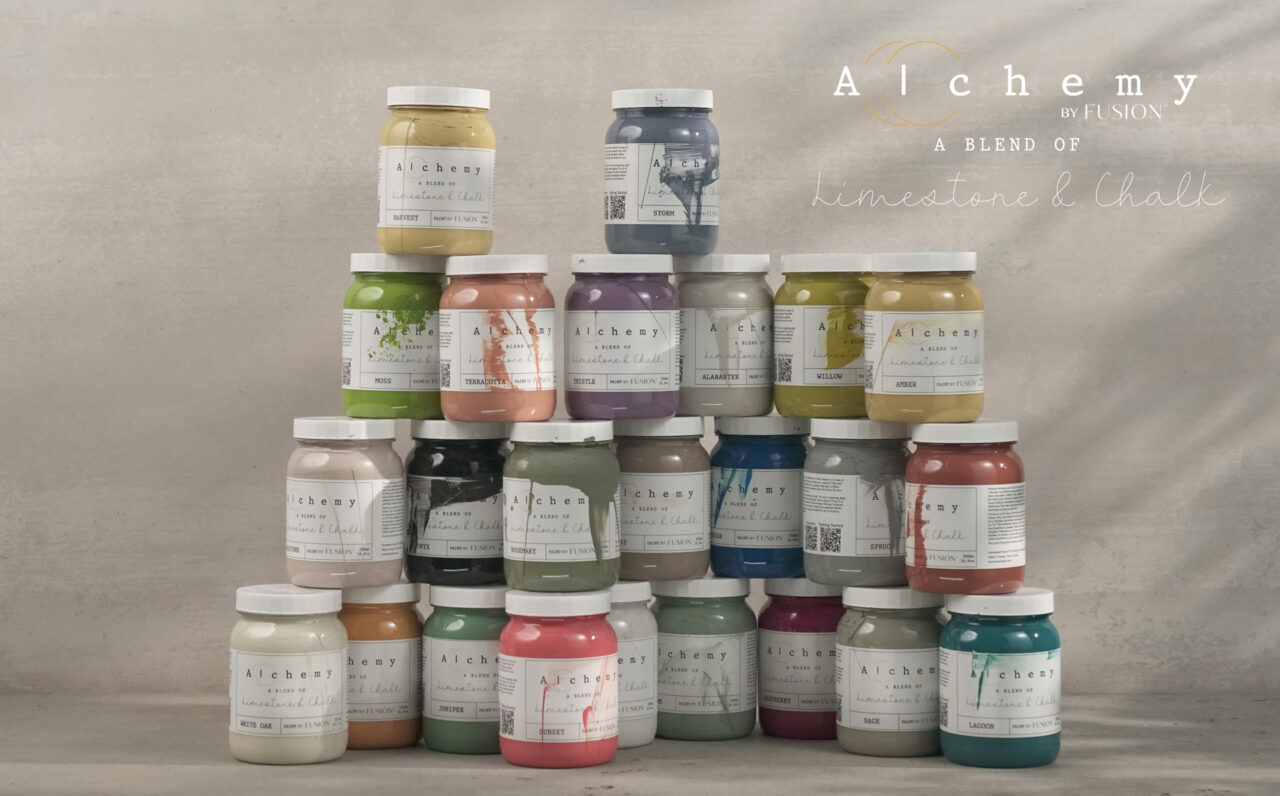At the heart of every piece of furniture lies untapped potential—hidden character waiting to be revealed. Our new chalk-style paint line, Alchemy, was designed for just that. Rooted in bold charm but made for the modern creative, Alchemy invites you to blend, layer, and experiment. Whether after rustic romance, timeworn elegance, or bold artistic expression, this is your invitation to transform the ordinary into the extraordinary with these Techniques for Transforming Furniture.
Take a sneak peek at our full tutorials to come with these 10 techniques, and be inspired to unleash your creativity.
Techniques for Transforming Furniture: Ombre blends
Create art with multiple shades blended while wet for a watercolour-like finish. Choose opposing colours or stick within the same colour family for any blended look.
Colours used from top to bottom: Raspberry, Sunset & Marigold
Steps to achieve this look:
- Block out what areas of your piece will have each colour, paint the sections close together
- Take your Fusion water mister and lightly mist over the joining sections
- Use your favourite Staalmeester brush to brush the sections into each other, blending the space in between the section,s creating a seamless blend
- Repeat as many times as necessary to get a solid blend
- If needed, use a watered-down final coat to make the ombre look more airbrushed by using a transparent final coat.
Colours used from top to bottom: 1. Half White Oak & Harvest 2. Harvest 3. Half Harvest & half Amber 4. Amber 5. Half Amber & half Marigold.
Steps to achieve this look:
- Make your mixes to achieve subtle tone differences from one shade to the next.
- Follow the same instructions as the blend above. Block out what areas of your piece will have each colour, and paint the sections close together
- Take your Fusion water mister and lightly mist over the joining sections
- Use your favourite Staalmeester brush to brush the sections into each other, blending the space in between the section,s creating a seamless blend
- Repeat as many times as necessary to get a solid blend
- If needed, use a watered-down final coat to make the ombre look more airbrushed by using a transparent final coat.
Techniques for Transforming Furniture: Crosshatched Layers & Dry Brushing
Lightly sweep colour over detailed surfaces to accentuate carvings and edges or to transform your piece into a work of art.
Colours used: Juniper, Onyx and Fusion copper metallic paint dry brushed
Steps to achieve this look:
- Paint your piece with the base colour of your choosing, ours was Juniper
- Take your second dominant colour and begin dry brushing layers up from the bottom. Work your brush up and down, and left to right, creating a crosshatch look. Similar to a woven fabric. Allow time between brush strokes to dry so you don’t pull your intentional paint lines.
- Layer your first colour (Juniper) with your second colour (Onyx) and create subtle, crosshatched layers.
- Work your final colour choice into your crosshatching around your piece and create immense depth on your piece. Layer until you reach your desired, finished look.
Techniques for Transforming Furniture: Distressing
Use sanding pads or a damp cloth to reveal layers beneath, giving your piece that aged, timeworn look.
Colours used: Ocean base coat, Sage top coat.
Steps to achieve this look:
- Paint your base coat colour, or colours, depending on the end result you want.
Tip: the more colours you have under your top coat, the more old and worn it’ll look. Authentic, old world pieces were painted many times, and you can see the layers through the distressing and chipping. You can mimic this old world look by adding multiple, multi-tone under layers.
- Paint your top coat a solid layer
- Sanding! Don’t let your paint cure for too long to make this step simple. Begin sanding away at high edges, corners and areas a piece would naturally experience wear and tear.
- Sanding options: dry sanding with a rough pad or wet sanding. Experiment! You may like one over the other, and it is all personal preference.
Techniques for Transforming Furniture: Textured Finishes
Create authentic texture with Alchemy on its own. Painting thick layers and using your brush to create texture. Pushing the brush into the paint, rather than painting long strokes.
Colours used: Alabaster, Rosemary & Clay
Steps to achieve this look:
- Forget long, end-to-end strokes. Use your brush as a texturizing tool but smooshing it into your piece to distribute the paint. You can even go back into your paint layer when it’s begun to dry to create an even thicker texture.
- Colour block where you want your colours to be, similar to the ombre piece.
- Leave your piece to dry for at least 24 hours! Because you’ve created a thick layer, it needs some extra time to dry and you don’t want to disturb the texture you’ve created by reactivating the paint too soon with moisture.
- Enjoy the texture you’ve created and highlight its character by dry brushing your colours around the piece. Coloured wax will also catch the beautiful textured hills in your paint!
- Layer your colours until you reach your desired end result.
Techniques for Transforming Furniture: Fresco texture
Pair Fresco with Alchemy to create bold texture for the ultimate depth and character.
Colours used: Moss, Onyx, Willow & Sienna.
Steps to achieve this look:
- Paint a base coat of your dominant colour.
- Take a cup and mix Fresco into your base colour, and add around your piece as a second layer in any and all areas you wish to have the fresco texture.
- Dry brush* layers of all other selected colours to create layers, intentionally highlighting the texture from the Fresco.
Bonus: Add a stencil in your layering to create a distressed, grungy look.
*See dry brushing explanation at the bottom of this blog!
Techniques for Transforming Furniture: Coloured waxes
Highlight depth and richness with colored or clear waxes that seal and enhance the finish.
Colours used: Terracotta with Fusion’s Espresso wax
Steps to achieve this look:
- Use a coloured wax around your piece to add depth
- Use more wax in the corners and crevices to highlight them more.
Techniques for Transforming Furniture: Stencilling & Raised Detail Work
Add pattern or texture using stencils, embossing paste, or layered paint techniques.
Colour used: Birch, Thistle, Spruce, Fusion’s Ageing wax & Embossing Paste.
Steps to achieve this look:
- Paint a base coat of your dominant colour, Birch was ours.
- Use Fusion’s Embossing Paste to create a dimensional raised stencil anywhere in your piece. We opted to use the empty door space front and centre with a stencil that resembled the wispy shape of the original hardware.
- Allow the embossing paste to fully dry for a day before painting over it.
- Dry brush subtle layers of your pairing colours, with a final dry brushed layer of your dominant colour to blend layers together.
- Use a coloured wax to further the depth of your piece and highlight the raised stencil more.
Techniques for Transforming Furniture: Metallic Accents & Gilding
Use metallic waxes for a touch of alchemist flair—perfect for drawer pulls or trim.
Colour used: Fusion’s vintage gold metallic paint dry brushed over Alabaster on the raised details
- Choose any of Fusion’s metallic colours to guild your piece. Select from a wide range of authentic gold, bronze and silvers to highlight details.
- Dry brush your metallic over appliques, high details or randomly throughout your piece if you want a metallic flair.
Or
- Paint a thicker layer if you want a bold metallic look.
Techniques for Transforming Furniture: Add Transfers
Apply a transfer to transform your piece into a story.
Floral transfer over the drawer front
Steps to achieve this look:
- Follow the instructions on your favourite transfer and apply it throughout your piece to create your own story.
- Seal with a Fusion wax or top coat to create an everlasting art piece
*Dry Brushing
Dry brushing is a decorative painting technique where you load a small amount of paint onto your brush, then wipe off the excess on a paper towel or piece of cardboard. With just a trace of paint left on the bristles, you lightly sweep the brush over raised surfaces. This allows the paint to catch only on the high points, creating a subtle highlight without covering the entire piece. On flat surfaces, dry brushing can give a distressed, timeworn effect that’s perfect for vintage or rustic styles.
Check out this video to see it in action!

With Alchemy, the only limit is your imagination. Whether you’re restoring heirlooms, giving new life to thrifted finds, or making bold artistic statements, this line was made to support your creative process. Stay tuned for in-depth tutorials and inspiration, and don’t forget to share your transformations with us—we can’t wait to see what you create!
Unleash your creativity.
Unleash your inner alchemist.



